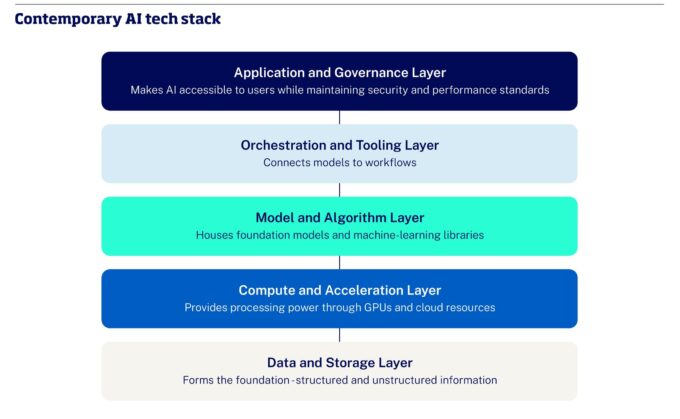
2026 AI trends: What leaders need to know to stay competitive
Is your organization AI-ready? IMD professors and researchers predict 2026 trends in artificial intelligence. Read on and prepare to innovate – or be left behind. ...

by Faisal Hoque Published July 16, 2025 in Artificial Intelligence • 8 min read
Artificial intelligence has received unprecedented levels of investment and enthusiasm over the last three years, yet the gap between the hype and the delivery of real business value remains stubbornly wide. A recent study from Boston Consulting Group suggests that while 98% of companies are exploring AI, only 4% have achieved significant returns on their investments, and just over a quarter (26%) have created any value at all.
So, why do so few AI initiatives deliver meaningful returns? The answer lies in a failure to align AI technology decisions with the organization’s strategic enterprise architecture – its overarching purpose and the people, processes, and existing technologies that are marshalled to pursue its strategic goals. Too often, AI deployments are led by a fascination with the new technology or a fear of missing out rather than by an analysis of the initiative’s fit with the broader business.
This is not a new problem. Misalignment between technology and business goals has been a problem since the dawn of the information technology revolution. As I argued in the Wall Street Journal after the bursting of the dot-com bubble, it is a challenge that organizations must work systematically to overcome. However, the stakes are exponentially higher with AI than with previous waves of technology, the integration points are more numerous, and the organizational impacts are more profound. Unlike earlier innovations that could be implemented at the departmental level with limited cross-functional impact, even seemingly modest AI initiatives ripple across the entire enterprise architecture.
In a recent article in MIT Sloan Management Review, my co-authors and I argued that a new type of leader is needed to coordinate the unprecedented scale and breadth of AI transformation across organizations. But successful AI implementation cannot rest on the shoulders of just one member of the C-suite. Every senior leader must be able to understand what AI promises, what it threatens, and how it will affect systems and strategies across the business as a whole.
This article offers a pragmatic guide for making decisions about which AI initiatives to support. It provides a concise overview of the technical knowledge that leaders will need if they are to make informed decisions and shows how the technology should be aligned with the broader enterprise-level architecture.

To create lasting value, AI initiatives must align with the organization’s strategic enterprise architecture (SEA). The notion of enterprise architecture first emerged in the 1980s and 1990s to describe the technical architecture of a business. When I introduced the terminology of strategic enterprise architecture in 2000 (e-Enterprise, Cambridge University Press), my goal was to highlight the often-overlooked idea that value creation depends on aligning this technical architecture with the broader structure of the business as a whole – its purpose, strategies, processes, and operating models.
Mapping out an SEA also serves another critical implementation purpose: it provides a common language and vision for everyone in the organization. This shared conceptual vocabulary is essential for thinking, talking, and planning cohesively across departments and disciplines.

“The most ambitious AI strategy won’t get anywhere without the right people to implement it. Success requires mapping out your organization's leadership model, talent composition, and skills profile.”
To understand which AI initiatives will create value for an organization, leaders first need clarity on four interconnected elements of the existing enterprise.
These elements describe the reason your business exists and how it aims to succeed in the marketplace. This includes your mission, vision, core values, competitive positioning, and strategic objectives. AI initiatives that directly advance these core purposes will naturally receive stronger organizational support and deliver greater value.
The most ambitious AI strategy won’t get anywhere without the right people to implement it. Success requires mapping out your organization’s leadership model, talent composition, and skills profile. Just as important is how the project aligns with the cultural values of the business.
The way work gets done within your organization determines the viability of specific approaches to implementing AI. Business processes, decision-making frameworks, governance models, and organizational hierarchies need to be mapped carefully to ensure that both the development and the day-to-day operation of an AI initiative are consistent with enterprise workflows.
While business leaders should understand AI on its own terms, successful implementation also means integrating this new technology with the existing enterprise tech stack. Current systems, data assets, infrastructure, and technical debt will all shape both what is possible with AI and how that potential can be realized.
Once leaders can picture how strategy, process, people, and existing tech fit together, they can then map the technical requirements of an AI initiative onto that same blueprint.
Once leaders can picture how strategy, process, people, and existing tech fit together, they can then map the technical requirements of an AI initiative onto that same blueprint. The contemporary AI tech stack illustrated below, comprises five interconnected layers: the data and storage layer forms the foundation, the compute and acceleration layer provides processing power through GPUs and cloud resources, the model and algorithm layer houses foundation models and machine-learning libraries, the orchestration and tooling layer connects models to workflows, and finally, the application and governance layer makes AI accessible to users while maintaining security and performance standards.

For further foundational information on AI tech stacks, see IBM’s introductory guide.
Successfully deploying AI initiatives means making choices at each layer to ensure alignment with organizational needs. Key considerations include deployment models (on-premises versus cloud-based versus hybrid approaches), open versus closed systems, computing resource needs, and data infrastructure requirements. Organizations with mature data infrastructure can implement AI more rapidly and effectively than those still struggling with data silos or quality issues.
Any level of misalignment between technical choices and the SEA can cause the failure of an AI initiative.
When Stability AI launched its popular Stable Diffusion image generator, it relied on infrastructure with cloud computer costs running at nearly $100m a year and operating costs taking another $54m. With no viable business plan to scale beyond its $11m in revenues, this was a classic example of technology/business misalignment.
The cost structure outpaced existing monetization strategy.
In 2023, Samsung employees’ use of ChatGPT for coding assistance led to the leak of highly valuable source code. This data leak stemmed from permitting the use of an external AI model that fell outside the company’s secure IT infrastructure and data governance policies.
Lax data governance jeopardized IP security.
Sports Illustrated’s use of AI-generated articles authored under fictitious bylines offered an efficient way of producing content. But the radical misalignment with the magazine’s brand promise of trusted information provider meant that the initiative ultimately harmed rather than helped the business.
Opaque AI use eroded longstanding reader trust.
Adobe's decision to train its in-house generative AI only on images owned by the company or in the public domain ensured that there would be no risk of outputs that infringed on intellectual property.
Adobe’s decision to train its in-house generative AI only on images owned by the company or in the public domain ensured that there would be no risk of outputs that infringed on intellectual property. This ensured that the technology could be freely used without liability concerns by Adobe’s commercial clients.
The rights-aligned dataset minimized downstream liability exposure for clients.
In 2023, Bloomberg released BloombergGPT, a large language model (LLM) trained specifically on financial data and news. Using a custom model enables Bloomberg to control model weighting and data flows within its own infrastructure, and to deliver assistance with financial tasks that outperformed general purpose models.
Domain-specific model reinforced premium client value proposition.
Unless you can answer “yes” to the following four questions – and provide evidence to support each answer – the AI initiative under consideration should not move forward.
A portfolio management approach can help enterprises systematically evaluate and prioritize multiple AI initiatives in the context of their evolving SEA.
As organizations develop a pipeline of AI projects, maintaining long-term alignment between technology and enterprise architecture becomes increasingly complex and increasingly important. A portfolio management approach can help enterprises systematically evaluate and prioritize multiple AI initiatives in the context of their evolving SEA. I discuss portfolio management principles extensively in my book Reinvent published by IMD, and with special reference to AI in my latest book, Transcend.
The AI landscape will continue to evolve rapidly, but the fundamental principles for successful implementation remain constant. Leaders who can align their organization’s AI initiatives with its strategic enterprise architecture will outperform those who fixate on the technology alone.

Founder of SHADOKA and NextChapter
Faisal Hoque, founder of SHADOKA, NextChapter, and other companies, is a three-time winner of Deloitte Technology Fast 50 and Fast 500™ awards and a bestselling author of ten books. His latest, TRANSCEND, a Financial Times book of the month and a “must-read” by the Next Big Idea Club, topped USA Today, Los Angeles Times, and Publishers Weekly bestseller lists. His previous book, REINVENT, a #1 Wall Street Journal bestseller, was published in association with IMD. For thirty years, Hoque has driven sustainable innovation, growth and transformation for organizations including MasterCard, American Express, GE, French Social Security Services, U.S. Department of Defense (DoD), U.S. Department of Homeland Security (DHS), PepsiCo, Chase, and IBM. Named among Ziff Davis’ Top 100 Most Influential People in Technology, his work has been featured in Fast Company, Financial Times, MIT Sloan Management Review, Harvard Business Review, Psychology Today, Wall Street Journal, and other leading publications.

December 26, 2025 • by Mark J. Greeven, José Parra Moyano, Michael R. Wade, Amit M. Joshi, Jialu Shan, Didier Bonnet, Robert Hooijberg in Artificial Intelligence
Is your organization AI-ready? IMD professors and researchers predict 2026 trends in artificial intelligence. Read on and prepare to innovate – or be left behind. ...

December 9, 2025 in Artificial Intelligence
AI is reshaping cybersecurity, arming both hackers and defenders. Learn how to stay ahead in the fast-evolving AI cybersecurity arms race....

December 1, 2025 • by Tomoko Yokoi in Artificial Intelligence
Vibe coding lets anyone build apps in plain English using AI, unlocking innovation and speed—but businesses must manage security, compliance, and quality risks....

November 25, 2025 • by Tomoko Yokoi, Michael R. Wade in Artificial Intelligence
IMD’s AI Maturity Index demonstrates how to align leadership, people, and technology for measurable business benefits and revenue growth, with examples from 10 industries....
Explore first person business intelligence from top minds curated for a global executive audience